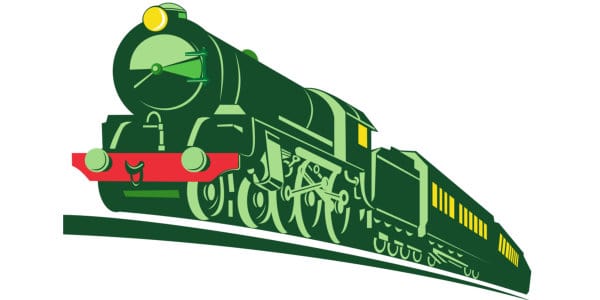John and I spent the first few days in the corridors, exploring the nearest carriages, in a train which seemed to us to be miles long. It was, indeed, such a lengthy train that, when we were travelling along a curved route, we could hang out of the windows, and see both the front and the back of the train at the same time, as it curled itself in various shapes according to the rails beneath. This we found fascinating, as was standing on the moving plates between one carriage and the next, trying to keep our balance as the plates moved continuously according to the curves of the track. Sometimes so tight was the circle of the train, we could see the windows of the carriages adjoining ours. Passengers would wave to each other from their respective windows. This was great fun, we thought.
Leaning out of a window was not the most sensible action on our parts, though, since, with endless carriages being pulled by a steam engine, the latter puffing out its polluted, soot-laden plume of smoke, John and I sometimes landed up with dirt or grit in our eyes, much to our discomfort. It probably wasn’t a good idea to be breathing in any of this “steam”, either, but in those days, we knew nothing about the dangers involved. It had to be better than the smog of Britain, which encompassed whole sections of the country. This was a mere plume of soot, from a single engine. Nevertheless, my parents sometimes had to wet the corner of a handkerchief, to get specks of dirt or soot out of our eyes.
The nicest part of the train was the dining car. It was almost impossible to believe that this restaurant was not in a first-class hotel (not that we had ever seen one!), but on a piece of rolling stock. It was stunning, with its deeply rich mahogany wood panelling, with its curtained windows, and its tables laid with white linen cloths, on which sat starched napkins in silver rings, gleaming glassware, sparkling dishes, and polished cutlery. Waiters, dressed immaculately in white uniforms, stood ready to take passengers’ orders. We all enjoyed going for meals, because not only were they exquisitely prepared and presented, but also because mealtimes broke up the monotony of the day for us. Of course, being youngsters, we three children didn’t know that there was an equally impressive “bar car” behind the dining car, where passengers would sit at a bar, or in comfortable armchairs, to smoke, to drink alcohol and to talk late into the night. My parents didn’t use that car, and so we never saw it.
When I took the same train trip in reverse fifteen years later, in January 1972, I looked in at the bar car, but I didn’t use it, either. As a single young lady, travelling on my own, and almost twenty-five years of age by then, I was not interested in meeting other people in a bar. I was far more focused on what lay ahead of me: first, a boat trip to England, and then a new life, working as an air hostess for British Overseas Airways Corporation. The world was going to be my oyster, and I could hardly wait!






Alison Watson3 years ago
Loved the characteristics of each train trip, especially the Japanese, who are a standout in organizational, when travelling.
Susan Leadlay3 years ago
Thank you for your comment, Alison. I am so glad you enjoyed my descriptions of the very different styles of travel by train, all well known to me.
Susan